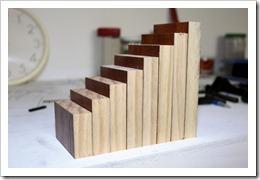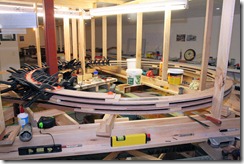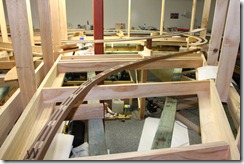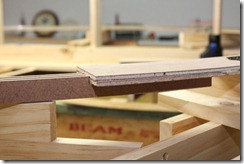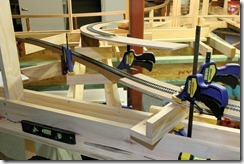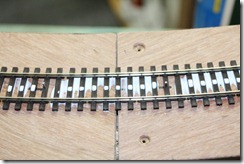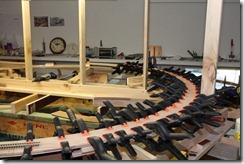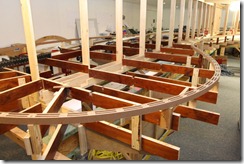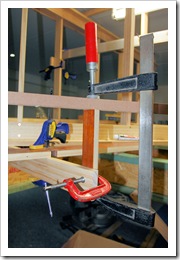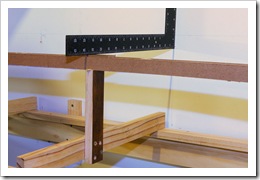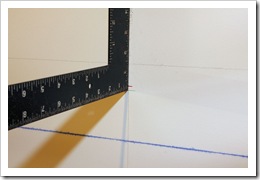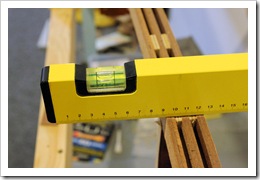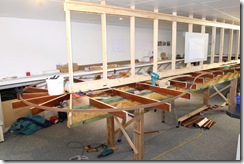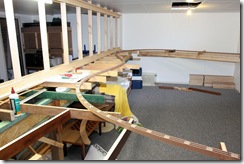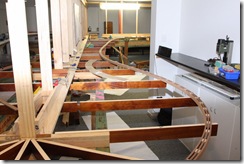Blog Archives
The Helix Part V …
Hi all,
Well, I have reached another milestone with the completion of the helix. When I say “completion”, it’s not 100% complete as I plan to put some ‘guard sides’ up on each of the layers to afford some protection to prevent trains from taking a plunge if they derail, but I plan to do this later on. But otherwise, the main structure is finished.
Following on from the last post, the next stage was to set the height of the first (bottom) layer to the correct height as this would then set the grade for the whole helix.
My initial attempt at this didn’t go so well, as I think I miscalculated the height of each sequential riser, eight in all. The reason I say this, is when the rest of the layers were lifted up into position, something didn’t look right. Some segments of the helix looked steeper than others.
The picture above shows the helix layers lifted up and spaced with temporary blocks at the correct height. This picture was taken with the first layer risers that were incorrect. To lift each layer up, it was just a matter of carefully lifting the whole thing and placing the temporary blocks in place at each of the eight support locations around the circumference. This was repeated for each layer.
After some later discussion with my consultant (Andrew), and after some more measurements and calculations, we came to the conclusion that I had indeed stuffed up the initial height calculations.
Some new risers were then cut, and fixed in position.
The pictures above shows the new first layer risers all cut and installed. These were glued to the L girders as well as the ply roadbed. After these were fitted, the whole helix looked much better and with even grades.
I had originally planned to make notched risers to support the helix at the eight points, but could not work out a way to accurately cut these notches. After some discussion again with Andrew, I decided to still use the 2×1 as the risers on the inside and outside, but just glue blocks in place to support the roadbed layers. See the pictures below.
The blocks were cut from some of the timber I had used to make the temporary spacer blocks. They were cut to about 15mm thick so as to not encroach too much onto the track and to allow enough room for the longest piece of rollingstock to pass through with clearance. The blocks are only glued to the risers and not the plywood. This should allow for any slight expansion and contraction in the timber.
Just to finish off, below are a couple of shots of the finished structure. I have also fitted the transition piece of ply roadbed from the top layer to where the spline will be attached at the 70 inch level. I am surprised at how rigid the whole structure is now.
Where you can see the red clamp, I have placed a temporary riser to support the transition section where the spline will attach.
At some stage, I want to temporarily connect a throttle of some sort to test run a loco up the helix.
Cheers for now.
The Helix Part IV …
Hi all,
Well, I completed the first stage of the helix today. All five layers are complete with track. The topmost layer of track has been left a bit short from the end of the roadbed as I will complete this part when I come to merge the helix with the upper deck roadbed at a later date.
The picture above shows the helix at about the halfway stage which was on 13 May.
The picture above shows the helix layers complete with track ready to have the final temporary spacer blocks fitted and then the notched risers. I hope to be able to have this all done by this time next week.
I was amazed at just how quickly it all went all together. I got into a rhythm of gluing the ply sections together, clamping then leaving for three hours. Whilst these were drying, I could lay track on a previously completed roadbed section up to the clamped section. I could lay three sections of 914mm track during this time and by the time I was finished, the glue had set on the next roadbed section, and the process started all over again. Each new roadbed layer was supported on temporary blocks to allow access for clamps. These can be seen in the photos.
Cheers for now.
The Helix Part III …
Hi all,
Since the last post, there’s been more movement on the helix build.
My package of PECO Code 75 flex-track from the UK arrived on Monday (30th). Before anyone starts on about why I didn’t buy it locally, I’ll tell you why. I got fifty 914mm (3ft) lengths delivered from the UK for $173.75. A quote I got from Brunel Hobbies in Melbourne was $176.60 (posted to Port Macquarie) for 25 lengths – double the price!! Why should I buy locally? If importers in this country feel the need to put such huge mark-ups on items sourced from overseas, is it any wonder they are complaining about internet sales taking away their business. I won’t say any more on the subject.
Anyway, back to the topic at hand.
Before track laying could commence, I had to build part of the first section of spline that would exit from the helix and continue on towards the storage yards. So, I did the usual thing of marking out where it would go using measurements from the 3rd Planit drawing. I also made a short transition piece of helix roadbed for the spline to attach to. I decided to only make a short section of spline so I could later remove it to rebate the top where it meets the helix.
Whilst the spline was being made, I mulled over how to start laying the flex-track. It’s funny to think that I have never really laid any flex-track in all my years of modelling. Anyway, first step was to mark a centreline on the helix roadbed. I then spent some time thinking of the best way to lay the track. As I would require joins on curves, I didn’t really want to just ‘butt’ join the sections as this generally does not allow for a smooth curve through the join. So I decided to stagger the joins. With PECO track, both rails are able to slide through the moulded chairs, so I pulled one rail back about nine sleepers, and cut away a couple of sleepers where the join would be. As I didn’t have any PECO rail joiners, I did the next best thing – a short piece of 30 thou brass wire soldered to the outside of each rail. Two lengths of track were joined together whilst straight.
Some more time was spent deciding on the best adhesive to use to fix the track down. I wanted to find something that would glue the plastic sleepers OK, be a strong bond, be fast setting but allow time to finalise placement. I didn’t want to be waiting around for hours whilst glue dried. After heading to Bunnings and looking in their adhesive section, I finally decided on a Selleys product called Aquadhere Quickset. It sets in about 5 minutes but fully cures in around 30 mins, is water-based and dries clear.
I also had to think about how I was going to hold the track in position in the curve whilst the glue dried. I decided to use small panel pins. This PECO track does not have any holes in the sleepers, so I drilled every tenth sleeper to make a neat fit for the panel pins.
Next, the track was placed on the helix roadbed and formed roughly into the correct curve. I managed to find a Tracksetta 36 inch radius template which will do the job nicely.
So basically, it was just a matter of placing the Tracksetta between the rails, ensuring the track was on the centreline and using the same small drill as before, drill a hole into the roadbed. The small panel pins were then pushed through the sleepers into the roadbed.
I also found out that my plan of using two lengths of track pre-soldered together was not the best move, as there was a bit too much pulling of the rail through the sleepers to adjust things on the curve as I went. For the next and subsequent layers, I’ll lay just the three foot lengths in turn. It’s much easier to pull the rail through the chairs in three feet rather than six feet.
The section of spline was removed from the benchwork and set up in a jig to allow for the rebate to be made to allow for splicing to the helix roadbed ply.
The picture below shows the spline now back in situ and glued to the helix roadbed. The spline was also set at the correct grade which at around 1.8%, is slightly steeper than the visible section of the layout but should still be OK. This is the same grade as the helix.
I decided to only fix in place a short section of track on the spline merging with the helix track, so I cut a strip of the foam tape roadbed and glued it to the spline. The foam was cut to the width of the spline, but to allow it to follow the curve, some cuts were made about 75% of the width to allow it to curve and remain flat. The cuts are just visible in the image below.
Another length of track was cut to splice into the section already tacked down on the helix. Some extra support for the spline was also installed here.
Today (6th) I glued the first layer of flex track down on the helix and the spline. For the spline section, I used some black caulking compound as a trial, as I was unsure how the Aquadhere Quickset would fix the plastic sleepers to the foam. A lot of articles I have seen about laying the Central Valley tie strips to foam roadbed mentions using caulk. The Aquahere Quickset was used on the helix sections though. Using a thin metal spatula, I carefully levered up the track a small amount, still making sure it was held by the nails. The glue was then dribbled over the sleepers, and using the spatula again, smeared underneath the sleepers and over the timber. The track was then pushed back down firmly. No weights were used to keep the track down as the nails were a firm fit in the holes in the sleepers, and seemed to hold OK.
Within half an hour, the glue had set enough for me to be confident the track was held in position. I then decided to start the next layer of helix roadbed. Some small blocks were cut to hold the new layer above the first whilst being glued and clamped.
With the number of clamps I have, I can only do about three segments at a time, but it should proceed reasonably quickly. Once another roadbed layer is complete, the tracklaying process starts again for that layer and so on until I end up with five layers of helix roadbed with track attached sitting on top of one another. The next stage will be to notch out the support risers, fix these in place, and lift the levels to the correct positions but that will be described in a later post.
I did also think about soldering the track feeder wires on prior to fixing the track down, but I think I can do this later.
Cheers for now.
Peninsula benchwork continues …
Hi all,
As I am still waiting on a parcel of track to arrive from the UK, work on the helix has come to a standstill. In the meantime, I have been continuing on with some benchwork on the peninsula. As the spline has been approaching the teardrop on the peninsula, the height of the risers has been getting quite high, which I found was resulting in a slightly unstable roadbed foundation, so I decided to build a second layer of joists to strengthen up the construction which in turn will shorten the risers.
This second layer of joists has also filled some of the ‘void’ between the spline and the bottom joists. This will save a lot of scenery ‘filling’ for no reason. Plus I didn’t really need so much depth below the spline. Refer to the pictures below.
The spline has also been set at the correct grade right up to the end of the teardrop. The photo below shows just how much the track will climb from the bridge at Chilcotts Creek (the gap in the spline on the right) to the teardrop. At this point, there is approximately a 13 inch (330mm) difference in height. The distance to this point is around 81 feet (24 metres).
The roadbed around the peninsula is now starting to get to a good height. I can just visualise the trains climbing this grade now!!
That’s all for now. Hopefully the next update will be on the next stage of helix construction.
Cheers for now.
The Helix Part II …
Hi all,
As mentioned in the previous helix post, I am basically following the design and construction techniques from this article in Model Railroad Hobbyist. It starts on page 61.
Rather than repeating what the article says, I will just explain what I have done, as things have gone a little differently.
Firstly, a template was made from 3mm ply for the helix segments. As my helix is only single track compared to double track in the article, I made my segments 90mm wide. I also made my segments as one-eighth of a circle to maximise what I could fit on an 8’ x 4’ sheet of 6mm ply with minimum waste. The helix requires 80 of these segments, 16 per level. As mentioned in the article, these get laminated together to form a roadbed of 12mm thickness which should be very strong and not require any splice plates. Splice plates have the disadvantage of reducing the clearance between levels.
The picture above shows eleven segments laid out on a piece of the 6mm ply. Three 8’ x 4’ sheets were purchased. As I could fit 33 segments on each sheet, these would give me plenty of room for the 80 required with some ply left over for possible entry and exit segments.
Once all the segments were cut out with a jigsaw, they were cleaned up with some sandpaper.
A lot of thought went into the next stage which was how to assemble the first helix layer. My situation differed from the article in that I could not just lay the segments out on the benchwork and go from there. There were obstacles in the way, namely the steel post and the already built benchwork.
So, it was decided to lay the segments out on the floor and glue them together.
Once the first layer was laid out, the next layer was glued to the top, with the segments overlapping by 50%. Using clamps to hold the segments whilst the glue dried was not an option, as I didn’t really want to disturb the segments in lifting them to install clamps. Small screws were used instead. These would be removed once the glue dried. During the process, measurements across the diameter were checked to see that I was in fact making a circle!
As mentioned in the article, the last overlapping segment was omitted at this stage. This was done, in my case at least, to enable this first level to be manipulated into the layout around the steel post etc.
During this time of cutting out helix segments, I also commenced work on the next section of benchwork to support the helix and the next section of spline heading towards Ardglen.
Another two I-beams were utilised again for the main supports with another L-girder wall constructed on top.
Now came time for locating the first helix layer in place. With Andrew’s assistance, we managed to get it in and around the steel post, but could not manipulate it around the wall ‘studs’ on the main peninsula. Three of these had to be removed to allow the helix to be moved into place. These were replaced later.
The final position of the helix was checked against the drawings and numerous measurements taken to get in in the right spot. It was then temporarily clamped in position.
The next stage was to construct ‘footings’ for the vertical risers which would support the helix structure. Referring to the article, this will be made from 2×1 DAR with notches cut about 12mm into the edge, spaced at the required separation distance.
Simple L-girders were made from scrap 3×1 and 2×1 in eight locations around the circumference, spaced evenly.
The above shots show the helix in position and the riser supports. There will be a 2×1 notched riser each side of the helix and they will be screwed to the 2×1 on which the helix is resting at the moment. Note that this first layer will be about seven inches higher that it is now. The bottom layer is around 49 inches elevation. Where it sits now gives me a solid base to construct the remaining four layers and to lay the track as I go. I am currently waiting on a shipment of PECO code 75 flex track from the UK before I can proceed any further. Flex track seemed to me to be the easiest method of laying track in the helix rather than using my handbuilt track method. The plan is to lay track on the first level, then construct the next level from the segments, lay the track on that level and so on. More on this later.
Cheers for now.
Setting the grade …
In this post, I will attempt to explain how I have gone about setting the grade for the spline from the bridge at Chilcott’s Creek, through Kankool and currently halfway to the teardrop. The same process will continue right through to Ardglen where it levels out halfway through the tunnel. Apologies for the length of this post, but I thought that putting it all in one post would be easier than splitting it.
Following on from the last post where I explained how I marked the 42” datum level around the layout using the water level, the next thing I did was to flick a chalk line on the walls against the marks made using the water level. I now had my datum “zero” level around the walls to Kankool.
When it came to making the marks along the peninsula benchwork, I soon realised that where the 42” level was, was about halfway up the joists sitting on the main girders. This initially proved tricky to get a true datum level, so I decided to mark out the 70” top track level on the peninsula walls using stringlines. I now basically had two datum levels from where to mark out riser heights.
In all the articles I have seen about spline roadbed, they always say to fix the risers in place first where you want the roadbed. I couldn’t see how this would work for two reasons :-
- I didn’t know exactly the route the roadbed would take. That’s the beauty of the spline – it’s adjustable.
- How do you set the riser heights, and therefore the grade, without having the spline in place to check for dips or bumps?
So, hence the reason for me building the spline flat on temporary joists, then when the time comes, fix in place the proper joists at set intervals, and then the process of setting the grade can commence.
The beauty of the 3rdPlanIt program is that you can set a grade and have it display the track height (elevation) at any location along the track.
The screen capture above is from the layout drawing in 3rdPlanIt and shows the locations of the joists along the route. The lines actually are the centrelines of the risers rather than the joists, but there is only a difference of about 20mm.
Once the grade has been set in 3rdPlanIt, a text marker can be placed along the track that shows the elevation at that particular point.
The screen capture above now shows the elevation markers at the joists. The values shown are based on a zero elevation at floor level, so because my datum level is 42”, I just took the difference between the two. So now I had my roadbed heights, I could now mark these at each riser location. Using a large square and spirit level, I drew vertical lines on the walls that lined up with where the risers would attach to the joists. The roadbed levels were then made around the walls by just measuring up from the 42” datum line and making a mark.
When it came to making these marks along the peninsula walls, I just reversed the process by taking the difference between the roadbed elevation and the 70” datum and measured down the wall ‘stud’.
Now that I had all the elevations marked out, it came time to cut up some timber to use for risers. Under the single track areas I used some 2×1 DAR and under the double track areas at Kankool, some 3×1.
I initially started to attach the risers to the joists first with the aim of then attaching the roadbed to the top of the riser later, but this proved to be not the right way to do it. I instead decided to glue the riser to the underside of the spline first, using Liquid Nails, and when set, I could then fix the riser in position. This would then also allow for slight twisting of the spline to ensure it is level.
The photo above shows a riser being glued and clamped to the spline. Note the riser is only temporarily clamped to the joist at this stage.
Now, a short side note. Up until early this week, I had fixed the roadbed/risers in position all the way through Kankool and half way down the first peninsular. The grade was looking good, then for some reason, when I was looking at the overall layout drawing, I realised that when I first drew the plan, I hadn’t allowed for the peninsula wall on the teardrop section, and consequently discovered I hadn’t allowed for enough scene depth behind the track at both Pangela on the top level and the corresponding track underneath it. AARRGGH!!!! So after about two hours redrawing this section of the layout and pushing the track out further to give around 400mm scene depth, I got it looking better. I then realised that I would have to recheck the grade through this section. When I did, it had changed slightly, which now meant all the roadbed I had previously fixed in place was about 7 mm high at each riser. *@#$%!!!!!!
Also, during this time when fixing some risers along the first peninsula, I came across another issue. I think I must have used a cheap glue when fixing the riser to the underside of the spline, because I had to twist a couple of risers quite a bit to get the spline level at that point, and it was here I noticed that the glue was letting go. So a solution had to be found. I went through a number of ideas, but I think this will solve the problem.
I had noticed that the problem lay generally on the inside of curves where I had to twist the spline to get it level. So a quick trip to the hardware store to get some hoop iron and small wood screws. Short sections were then cut and bent to shape for each location and screwed to the spline and riser. I may have to rethink the riser to spline attachment process, but for now I have changed to a known brand of adhesive, namely Max Bond. I may have to use the method described here and nail the spline to the riser to compliment the glue. See pages 20 and 21.
So, after that issue was sorted out, I printed out another layout drawing showing the revised elevation heights and proceeded to remark the heights and drop the risers down. In the meantime I have also added more joists on the teardrop and started laying out more spline along the other side of this peninsula.
Now, back to the elevation setting process.
With the spline sitting on temporary risers, clamped roughly at the right height, I had to devise a way of accurately getting the riser at the right height. I ended up using a steel right angle square held against the wall at each location with it’s bottom edge lined up with the height mark, and either raised or lowered the riser until it touched the square. The riser was then clamped in position and screwed to the joist, after checking for level (see below). A small piece of scrap masonite was placed on top of the spline to allow for the foam roadbed, as all roadbed heights referred back to this datum ie 42”.
The two images above show the square in position against the wall with the masonite packer, and a close-up of the elevation mark on the wall (the green line) and the 42” datum (the blue chalk line). The red line was the previous elevation mark prior to the track changes on the peninsula mentioned above. At this point in the process, before fixing the riser, a spirit level was placed on top of the spline to check for level.
Well, that’s about where things are up to at the moment. I hope it all makes sense, as sometimes I find it difficult to put into words how I do something. As mentioned above, I have started to install joists further along the other side of the teardrop peninsula so I can resume spline construction here.
Over the last week I have also got my hands on some more photos of the area. I posted a message on RailPage Australia asking for photos of the signals and structures at Kankool, Ardglen and Pangela. I eventually heard from a couple of blokes who are ex train drivers, and are both sourcing more stuff for me. Some I have already received from one are real beauties. If anyone else out there has any photos of the area, please let me know.
Cheers for now.
Spline continues …
Hi all,
I have now completed full spline past the teardrop on the main peninsula. Since the last post, I installed the temporary joists to support the spline up to and around the teardrop.
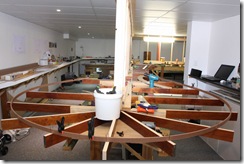 As described previously, the first job is to set out the two centre strips, held in place by nails and temporarily clamped together. Then, using a plywood template set to 40 inch radius, the centre strips are then adjusted to the correct radius. Once the final position of the spline looks OK, the centre strips are glued and clamped together. Then the normal process of attaching the spacer blocks and the other spline strips continues.
As described previously, the first job is to set out the two centre strips, held in place by nails and temporarily clamped together. Then, using a plywood template set to 40 inch radius, the centre strips are then adjusted to the correct radius. Once the final position of the spline looks OK, the centre strips are glued and clamped together. Then the normal process of attaching the spacer blocks and the other spline strips continues.
Just to finish off, following a request from a fellow modeller, here is a shot of the track plan showing spline progress to date. The red line shows where I am currently up to, and shows a distance of 92 feet of spline completed.
Cheers.
Spline roadbed Part I …
Hi all,
Yesterday I had delivered some masonite sheets to use for the spline roadbed. The sheets were 8’ x 4’ x 1/8”. I bought three at this stage.
Today I spent the morning cutting the sheets into 25mm wide strips. The three sheets were clamped together and then I used a straight edge as a guide for the circular saw. The three sheets produced 120 strips which equals 960 feet of spline material.
Now, over the last few weeks, I have been working out the details of the spline ie what width and whether I should use solid or ‘open’ spline. I have decided to go with the ‘open’ spline.
As can be seen, six strips will be used for the spline, which will end up around 31mm wide. So from this first batch of masonite, I’ll get about 160 feet of spline.
I have always wanted to use closed cell foam as the roadbed, mainly for its noise deadening properties. This afternoon I went down to the local Clark Rubber to see what they had. After some discussion with the bloke, I came away with a 9.5m roll of self adhesive foam tape, 3.5mm thick by 150mm wide. The stuff was $8.95 per metre, but the plan is to cut it into strips around 20mm wide to go on top of the spline, one each either side of the track centreline, so I’ll end up with about seven times the quantity which works out to be around $1.30 per metre which is not too bad.
I had originally thought about getting the foam in sheets and cutting it into strips, but the Clark Rubber bloke said that the sheets cannot be guaranteed to be uniform thickness, whereas the tape is, which is better.
Also, with the tape having adhesive on one side, I think it will make it nice and easy to attach to the spline.
So after the foam is down, next comes the Central Valley tie strips. More on this later when I get to that stage.
I hope to make a start on the spline tomorrow, with the first job to work out how to start and attach the spline from the end of the storage yards plywood top. More updates as things progress.
Cheers for now.

